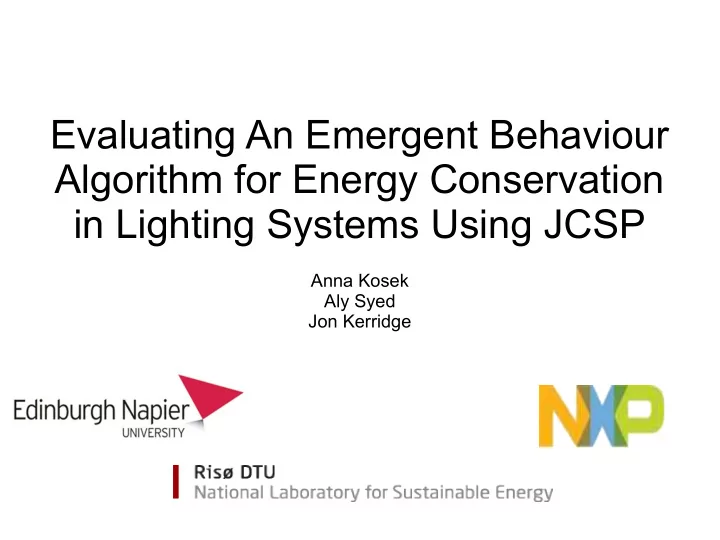

Evaluating An Emergent Behaviour Algorithm for Energy Conservation in Lighting Systems Using JCSP Anna Kosek Aly Syed Jon Kerridge
Energy saving ● Beneficial for the environment ● Saving money ● Helps reducing load peaks in the power system 2
Building automation system trends ● Pervasive ● Distributed ● Adaptive ● Performing “intelligent” behaviour 3
The Brick Factory ● Material ● Cheap (limited), ● expensive (not limited). ● Employees ● Manager 4
Challenges ● Is it possible to make this brick making company reliable, as long as there are employees to work? ● How to minimize the production cost by using available employees and material? 5
Lazy and Enthusiastic Employee algorithm Request Lazy Enthusiastic employee employee The overall Waits and Starts working production is to increases the immediately at small workload only full speed slightly The overall Stops working Waits and production is to immediately decrease the large workload only slightly 6
Employees behaviour ● The first reaction is crucial ● Reduction of feedback loop problem ● Various reaction ● Various increase/decrease factor 7
Margin 8
Increase/decrease factor ● Independent of the actual production rate ● Constant (linear) ● Variable (based on a curve) ● Dependent of the actual production rate ● Distance-based 9
Constant factor Enthusiastic Lazy Increase Decrease 10
Various factor 11
Distance-dependent factor 12
Margin 13
Experiment set-up ● 100 Lazy workers ● 100 Enthusiastic workers ● Ideal production 10,000 bricks/minute ● All start from 0 bricks/minute ● Default increase factor is 10 bricks/minute ● Cheap material 1$, expensive material 10$ 14
Reference data 15
Constant factor 16
Various factor 17
Distance-dependent factor 18
Results Function Cheap Expensive Overall Factory used bricks bricks cost cost ($) reliability cost ($) ($) (%) constant 798601 800520 1599121 72 various 84390 0 89390 84 no function 435400 4354000 4789400 76 distance 891502 936440 1827942 94 dependent 19
Scenario 20
Implementation 21
Input data 22
Results 23
Energy usage Algorithm Energy usage (J) No algorithm, all 86700 lamps 100% dim Dimming control, no 31428 algorithm L&EE Algorithm 16019 81,5 % energy savings! 24
Questions? 25
Recommend
More recommend